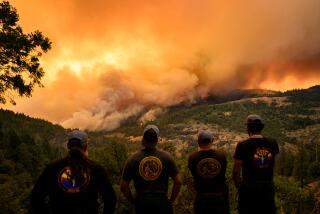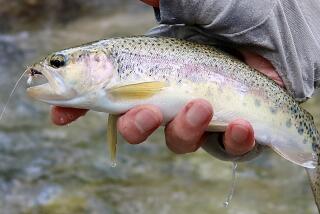Outdoor Notes : Grunion Are Back in the Starting Blocks
Fishermen who rely on quick feet and sure hands instead of hooks and rods will be patrolling Southern California’s wide, sandy beaches beginning March 8, when the first major grunion run is expected.
Grunion are silvery little fish that wriggle out of the surf and onto beaches to spawn between February and September. The most favorable tides for catching grunion, however, occur between March and August. Grunion can be taken only by hand, and a fishing license is required.
Grunion spawning runs are expected on the following dates (times shown after each date indicate the start of a favorable two-hour tidal period):
March--8 (10:24 p.m.), 9 (11:02 p.m.), 10 (11:44 p.m.), 12 (12:32 a.m.), 23 (10:05 p.m.), 24 (10:27 p.m.), 25 (10:52 p.m.), 26 (11:23 p.m.).
June--4 (10:36 p.m.), 5 (11:22 p.m.), 7 (12:14 a.m.), 8 (1:10 a.m.), 20 (10:49 p.m.), 21 (11:31 p.m.), 23 (12:20 a.m.), 24 (1:23 a.m.).
July--4 (11:08 p.m.), 5 (11:54 p.m.), 7 (12:41 a.m.), 8 (1:33 a.m.), 19 (10:44 p.m.), 20 (11:27 p.m.), 22 (12:15 a.m.), 23 (1:14 a.m.).
Aug.--2 (10:51 p.m.), 3 (11:30 p.m.), 5 (12:09 a.m.), 6 (12:54 a.m.).
California’s state fish hatcheries apparently haven’t seen the end of whirling disease, the fish malady that killed several million trout at the Mount Whitney and Black Rock state hatcheries in the Eastern Sierra last year.
An outbreak of the fish disease has struck the Darrah Springs hatchery in eastern Shasta County. Workers there began destroying 366,000 hatchery rainbow trout this week, trying to prevent the parasitic disease from drifting downstream to Coleman national fish hatchery on Battle Creek.
In the meantime, state hatchery personnel are watching Mount Shasta hatchery in Siskiyou County, where some evidence of the disease was observed last week in both the hatchery and a feeder stream that supplies water to the hatchery.
Whirling disease, harmless to humans, causes abnormalities in trout, the most visible being “tail chasing syndrome,” after the parasite begins attacking the trout’s brain.
Bass clubs in both Nevada and California have turned to a new way of creating largemouth bass habitat--throwing old or unsold Christmas trees in the lake.
About 60 Las Vegas-area bass fishermen showed up at Lake Mead’s Callville Bay recently in freezing winds to help sink about 8,000 weighted Christmas trees in 20 to 25 feet of water in the bay.
At San Antonio Reservoir in Monterey County, a similar project was undertaken by the Monterey County Unified Sportsmen’s Assn., using about 1,500 unsold Christmas trees.
In both cases, fishermen and biologists hope the trees provide needed cover for juvenile bass.
Colorado’s “Operation Game Thief,” a program whereby citizens can report wildlife law violations and receive rewards, may be too successful. Colorado’s Division of Wildlife says rewards have been paid out faster than contributions have been made to the reward fund.
The program began in 1980, and rewards have totaled $140,000 in cases involving more than 400 poachers. The reward fund, however, has dropped to $2,000, officials said.
Briefly San Diego-based long-range skippers Don Sansome and Frank LoPreste will conduct long-range fishing seminars at Art’s Tackle, Gardena, at 11 a.m. and 2 p.m. Saturday. . . . The Western Fishing Tackle & Fishing Boat Shows are scheduled for March 6-10 at the Del Mar Fairgrounds, and March 20-24 at Long Beach Convention Center. . . . Gary Robson, Corona, earned $56,000 for winning the U.S. Bass Lake Havasu Invitational recently. . . . A Phillips Petroleum Company application to seek geothermal deposits on U.S. Forest Service land in the southern Sierra is opposed by the Department of Fish and Game because it would endanger a mule deer herd. . . . Idaho wildlife officials want to have one free fishing day a year, to promote fishing license sales. . . . Ed Danberg, Sepulveda, recently caught a 42-pound, 6-ounce California halibut in Santa Monica Bay, believed to be the largest taken there since World War II. . . . The DFG is completing the stocking of about 20,000 yearling striped bass in Southland bays and harbors, topped by 10,000 young stripers planted in San Diego’s Mission Bay. . . . William H. Geer was named recently as director of Utah’s Division of Wildlife Resources.
More to Read
Sign up for Essential California
The most important California stories and recommendations in your inbox every morning.
You may occasionally receive promotional content from the Los Angeles Times.










